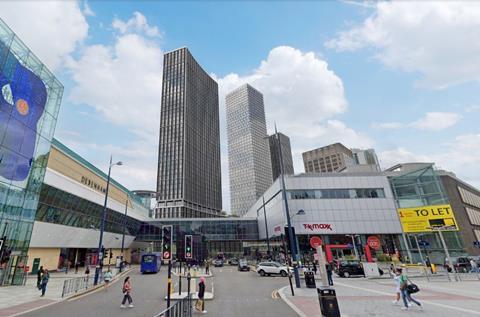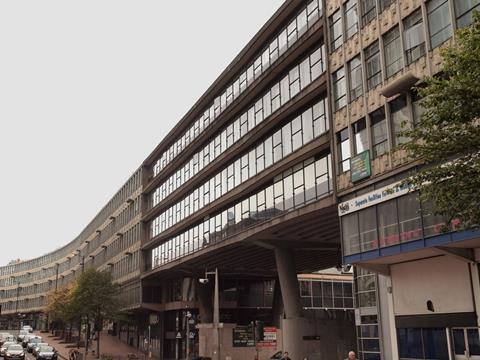Corstorphine & Wright proposals would replace landmark with three blocks up to 56 storeys in height
The future of Birmingham’s Ringway centre is set to be decided later this week as councillors meet to discuss plans to replace the 1960s landmark with three towers.
The Corstorphine & Wright-designed scheme would demolish the locally listed building and see the construction of a trio of towers which would be among the tallest in the city.

The highly controversial proposals have been recommended for approval by the council’s planning officer despite staunch objections from campaigners including the 20th Century Society, the Birmingham Civic Society and Brutiful Birmingham.
Historic England has also expressed its concern and questioned what “positive efforts” have been undertaken to preserve the RIngway Centre, a council requirement for Grade B listed buildings.
The six-storey landmark was completed in 1962 and snakes along the city’s Inner Ring Road immediately outside the Bull Ring shopping centre.
Currently vacant, the Ringway was designed by James Roberts, the architect of the grade II-listed Rotunda, Birmingham’s most famous brutalist building.
A hybrid application for the redevelopment submitted in November last year by developer CEG would see two thirds of the building, including a bridge which links two parts of the structure, demolished and replaced by a 48-storey tower containing 547 flats.
A second phase would flatten the remainder of the building and erect two further towers of 44 and 56 storeys, consisting of a total of 1,085 homes and 6,400sq m of commercial space.
A ‘meanwhile use’ strategy has been proposed for the part of the site earmarked for the tallest tower if the scheme is delayed, with the preferred option being a small park.
The council’s planning officers have concluded that the proposals would result in “high quality” residential development which would make a meaningful contribution towards Birmingham’s housing needs.
The officers’ report added that the scheme would create a “distinctive place” and provide economic, social and environmental benefits.
But the 20th Century Society said the loss of the Ringway Centre would cause “serious, substantial harm” and said the heritage significance of the building had been “undersold”.

The group also argued the building was capable of being adapted for reuse and extended upwards if required, countering claims from CEG that such a scheme would require “significant and costly interventions”.
The scheme’s planning consultant Turley has submitted an eight-page assessment of the viability of a retrofit as a direct response to Michael Gove’s decision to reject Marks & Spencer’s plan to rebuild its Marble Arch store on net zero and heritage grounds.
In his letter setting out his reasons for rejection, the secretary of state said there should be a “generally” strong presumption in favour of repurposing and reuse of buildings.
But Turley argued there would be a significant risk in “misinterpreting” this judgment as meaning a blanket ban against demolition of all buildings, which the consultant said would set a particularly harmful precedent in Birmingham given the city’s regeneration ambitions.
The document sets out the differences between the Pilbrow & Partners-designed M&S scheme and the Ringway Centre plans, including that the former had been primarily for commercial use and the latter would be residential-led.
Turley added that while the M&S store was still in use, the Ringway Centre was unoccupied, no longer fit for purpose and argued it was approaching the end of its design life in terms of structural integrity.
It concluded that the project team had “fully and robustly” tested the feasibility of retaining the Ringway Centre and found retention would not be viable as it would require works such as recladding, installing new fire safety measures and repositioning floor plates.
“The reality is that such works would be prohibitively costly without the benefit of likely proportionate returns on investment,” Turley said.
“This represents a particular constraint when considering the need for any office or residential proposals to compete with other contemporary purpose built developments in the city that provide high quality accommodation and various other services and amenities.
“In that context the scale of intervention works and repairs necessary to bring the building back into a ‘fit state’ for long term occupation would set a high burden on the deliverability of any such proposals and their realistic deliverability”.
The project team also includes cost consultant RLF, structural and civil engineer Curtins, heritage consultant Montagu Evans, facade engineer Wintech, transport consultant Stantec and acoustic consultant Hoare Lea. The hearing will take place on Thursday.










No comments yet